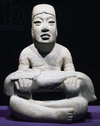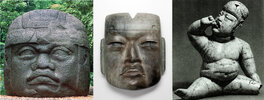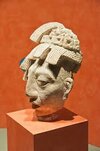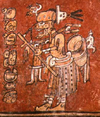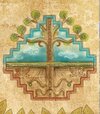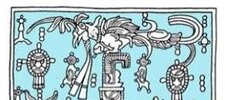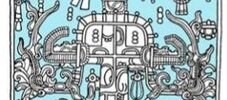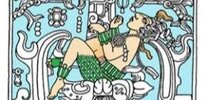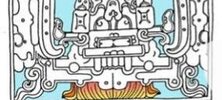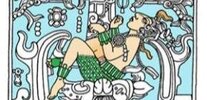Jtucker
Jedi Master
I've spent quite a bit of time over the past twenty years trying to make some sense out of the ancient Mayan world that appears to have been almost completely abandoned sometime in 8th or 9th centuries. My feeling that this dating is probably skewed by our own western timeline assumptions, and I wouldn't be surprised if the abandonment date is much closer to the end of the Roman Empire under Justinian in the 6th century.
Mayan cosmology is elusively weird to the western mind and I believe, intrinsically hyper-dimensional. I've never found anything quite like it.
Luckily, it is one of the best preserved ancient systems available to decipher and we have the advantage that there aren't numerous "re-inventions" of the past like European history where we have to peel back the layers of forgeries and interpolations. Mayan glyphs, frescoes and artifacts all exist in droves and many excellent researchers have made headway deciphering them. The Mayans that "remained" in the Yucatan after the so-called "collapse" also have a rich memory of their past and haven't been as subjected to "modern thought reform" as much as many other traditional societies.
I can't say I've figured out anything concrete, so this isn't a thesis per se, but rather some connected dots utilizing Younger Dryas research, Pierre's excellent work on Comets and the Human Cosmic Connection (which is a main theme in Mayan cosmology) as well as some old sessions for from the C's.
I'll start with the C's sessions that dealt with Maya world.
From December 10, 1994:
Q: (L) What happened to the Mayans?
A: Taken by Lizard beings to cosmos in 4 D "Lizzieland."
Q: (L) What did they do with them there?
A: Many possibilities.
These answers are both fascinating and elusively opaque.
I haven't discovered anything in research that points to a specific world equating to our understanding of "Lizzieland", but Mayan cosmology definitely has a "Starry World" and an "Underground World" that are separate realms from surface earth. The Starry World doesn't seem to be a physically inhabited realm, but the Underground world seems to be a place that can be at least "semi-physically" visited and some times permanently. As I'll try to show later on in this thread, many aspects of this Underground world parallel our sparse understanding of the breakaway Atlantean underground world that contains Hyper-dimensional qualities.
This is an image from Palenque that the Ancient Alien dudes like to speculate as the Mayan King Pakal flying a space ship. From the context and the more mainstream research, this is more likely a depiction of a trip to the Underworld.

Palenque, Chiapas:
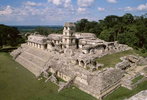
From the February 25, 1995 Session:
Q: (BP) Were the Mayans an STS civilization?
A: No.
Q: (BP) Why did they engage in human sacrifice and so forth?
A: They did not.
Q: (BP) They did not?! (L) I think that's an archaeological fallacy. (TM) Yes. (BP) Isn't that fascinating!
The answer that Mayans weren't an STS civilization is a little confusing. Aren't we all in an STS realm? As for the human sacrifice, I would have to agree that the evidence is pretty weak. Although at Chichen Itza, there is some evidence. But this is a very late city in their history with much northern influence from Mexico. Also, the human sacrifice-type remains that have been found could have easily happened long after the city's main period in a following "Dark Age" after the abandonment. However, ritual self-bloodletting was a big part of the elite ceremonies and is depicted regularly in artwork.
From a Wiki type description that I'll elaborate on in more Mayan terms later:
Letting blood using implements like sharpened bone, stingray spines, thorny ropes, and obsidian blades provided the Maya the means to petition their ancestors and the gods for rain, good harvests, and success in warfare, among other needs and desires.
From the Oct.7 1994 Session:
Q: (L) Where else did the Atlanteans go?
A: Americas. Inca. Aztec. Maya. Hopi Tribe. Pima tribe.
This comment by the C's matches up with Hopi traditions:
“The inhabitants of Atlantis had researched secrets of the Creator for which they were not spiritually ready. They had obtained knowledge of such things too early and used it to subjugate other people. In doing so, they infringed on the divine order. They also studied other planets, and they even went there,” White Bear said. “These were dead planets where no one could live, so they had to remain on our good old Earth.”
Link below to Graham Hancock's full article on the subject:
Sunken Land of The Hopi Ancestors
To paraphrase the above article as well as some other Hopi interviews, essentially their original homeland was being destroyed by flooding and they were rescued by "Ant People" and transported to the Yucatan. The conflict in Altantis/Mu is similar to how Cayce described it as well as recent remote viewers (The Sons of Belial vs. The Sons of the Law of One). At the onset of the resettlement in the Yucatan, the founders were apparently committed to The Law of One, but slowly corruption and lust for power crept into the rulers at Palenque. They seemed to be repeating the same errors as the Atlanteans and a major split occurred. The Hopi left the Yucatan and migrated north into Arizona where they chose to commit themselves to a more simple life and avoid the disaster they believed Palenque was in for.
On a personal note, we've spent a lot of time in the Yucatan and have a number of Mayan friends. A few years ago my wife and I visited the Grand Canyon and stayed in Tuba City AZ (the main Hopi Town) and were both shocked how similar many of the Hopi looked to our Mayan friends in Yucatan. None of the neighbouring Navajo had similar features, but resembled our northern people much more.
From the August.8.1995 Session:
Q: (L) Who and what were the Mayans?
A: The Mayans were a transitory people who still exist in the lands that you refer to as Central America. And who have certain physical features that are not consistent with the rest of human beings on 3rd density Earth environment, due to their interactions, in the past, as you measure time, with beings of other density levels.
Q: (L) What beings would those be?
A: Well, we have described 4th density STS beings on many occasions.
Q: (L) The Lizard Beings?
A: Indeed.
So the C's bring us right back around full circle!
The Mayans weren't an "STS Civilization" but they have been genetically tweaked by 4D STS and they were a "Transitory People" who still exist in the Yucatan? That's a tough sentence to wrap your head around.
I'll propose some evidence to try and back this speculation up in future posts. But my thinking is that the Mayan elite or a portion of them were either bi-density or became bi-density at some point.
How (a portion of) the Maya got "transported" to 4D is a whole other can of worms that I'll leave my speculations out until last.
But in the next few posts I'll try and highlight the Mayan ideas of cyclical catastrophes, information field interfaces and their bizarre interactions and journeys to the underworld that seem less and less mythical and more concrete as we uncover more info on the breakaway undergrounders from Atlantis
Mayan cosmology is elusively weird to the western mind and I believe, intrinsically hyper-dimensional. I've never found anything quite like it.
Luckily, it is one of the best preserved ancient systems available to decipher and we have the advantage that there aren't numerous "re-inventions" of the past like European history where we have to peel back the layers of forgeries and interpolations. Mayan glyphs, frescoes and artifacts all exist in droves and many excellent researchers have made headway deciphering them. The Mayans that "remained" in the Yucatan after the so-called "collapse" also have a rich memory of their past and haven't been as subjected to "modern thought reform" as much as many other traditional societies.
I can't say I've figured out anything concrete, so this isn't a thesis per se, but rather some connected dots utilizing Younger Dryas research, Pierre's excellent work on Comets and the Human Cosmic Connection (which is a main theme in Mayan cosmology) as well as some old sessions for from the C's.
I'll start with the C's sessions that dealt with Maya world.
From December 10, 1994:
Q: (L) What happened to the Mayans?
A: Taken by Lizard beings to cosmos in 4 D "Lizzieland."
Q: (L) What did they do with them there?
A: Many possibilities.
These answers are both fascinating and elusively opaque.
I haven't discovered anything in research that points to a specific world equating to our understanding of "Lizzieland", but Mayan cosmology definitely has a "Starry World" and an "Underground World" that are separate realms from surface earth. The Starry World doesn't seem to be a physically inhabited realm, but the Underground world seems to be a place that can be at least "semi-physically" visited and some times permanently. As I'll try to show later on in this thread, many aspects of this Underground world parallel our sparse understanding of the breakaway Atlantean underground world that contains Hyper-dimensional qualities.
This is an image from Palenque that the Ancient Alien dudes like to speculate as the Mayan King Pakal flying a space ship. From the context and the more mainstream research, this is more likely a depiction of a trip to the Underworld.

Palenque, Chiapas:

From the February 25, 1995 Session:
Q: (BP) Were the Mayans an STS civilization?
A: No.
Q: (BP) Why did they engage in human sacrifice and so forth?
A: They did not.
Q: (BP) They did not?! (L) I think that's an archaeological fallacy. (TM) Yes. (BP) Isn't that fascinating!
The answer that Mayans weren't an STS civilization is a little confusing. Aren't we all in an STS realm? As for the human sacrifice, I would have to agree that the evidence is pretty weak. Although at Chichen Itza, there is some evidence. But this is a very late city in their history with much northern influence from Mexico. Also, the human sacrifice-type remains that have been found could have easily happened long after the city's main period in a following "Dark Age" after the abandonment. However, ritual self-bloodletting was a big part of the elite ceremonies and is depicted regularly in artwork.
From a Wiki type description that I'll elaborate on in more Mayan terms later:
Letting blood using implements like sharpened bone, stingray spines, thorny ropes, and obsidian blades provided the Maya the means to petition their ancestors and the gods for rain, good harvests, and success in warfare, among other needs and desires.
From the Oct.7 1994 Session:
Q: (L) Where else did the Atlanteans go?
A: Americas. Inca. Aztec. Maya. Hopi Tribe. Pima tribe.
This comment by the C's matches up with Hopi traditions:
“The inhabitants of Atlantis had researched secrets of the Creator for which they were not spiritually ready. They had obtained knowledge of such things too early and used it to subjugate other people. In doing so, they infringed on the divine order. They also studied other planets, and they even went there,” White Bear said. “These were dead planets where no one could live, so they had to remain on our good old Earth.”
Link below to Graham Hancock's full article on the subject:
Sunken Land of The Hopi Ancestors
To paraphrase the above article as well as some other Hopi interviews, essentially their original homeland was being destroyed by flooding and they were rescued by "Ant People" and transported to the Yucatan. The conflict in Altantis/Mu is similar to how Cayce described it as well as recent remote viewers (The Sons of Belial vs. The Sons of the Law of One). At the onset of the resettlement in the Yucatan, the founders were apparently committed to The Law of One, but slowly corruption and lust for power crept into the rulers at Palenque. They seemed to be repeating the same errors as the Atlanteans and a major split occurred. The Hopi left the Yucatan and migrated north into Arizona where they chose to commit themselves to a more simple life and avoid the disaster they believed Palenque was in for.
On a personal note, we've spent a lot of time in the Yucatan and have a number of Mayan friends. A few years ago my wife and I visited the Grand Canyon and stayed in Tuba City AZ (the main Hopi Town) and were both shocked how similar many of the Hopi looked to our Mayan friends in Yucatan. None of the neighbouring Navajo had similar features, but resembled our northern people much more.
From the August.8.1995 Session:
Q: (L) Who and what were the Mayans?
A: The Mayans were a transitory people who still exist in the lands that you refer to as Central America. And who have certain physical features that are not consistent with the rest of human beings on 3rd density Earth environment, due to their interactions, in the past, as you measure time, with beings of other density levels.
Q: (L) What beings would those be?
A: Well, we have described 4th density STS beings on many occasions.
Q: (L) The Lizard Beings?
A: Indeed.
So the C's bring us right back around full circle!
The Mayans weren't an "STS Civilization" but they have been genetically tweaked by 4D STS and they were a "Transitory People" who still exist in the Yucatan? That's a tough sentence to wrap your head around.
I'll propose some evidence to try and back this speculation up in future posts. But my thinking is that the Mayan elite or a portion of them were either bi-density or became bi-density at some point.
How (a portion of) the Maya got "transported" to 4D is a whole other can of worms that I'll leave my speculations out until last.
But in the next few posts I'll try and highlight the Mayan ideas of cyclical catastrophes, information field interfaces and their bizarre interactions and journeys to the underworld that seem less and less mythical and more concrete as we uncover more info on the breakaway undergrounders from Atlantis

